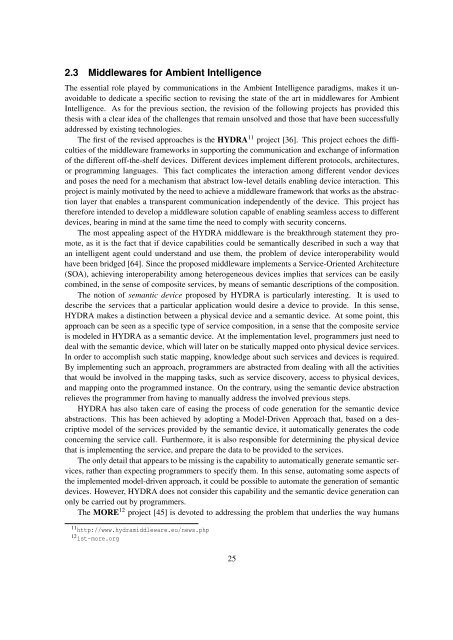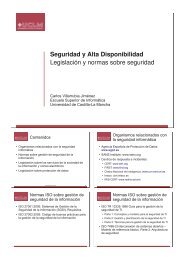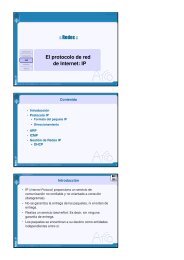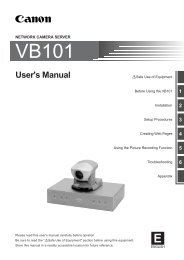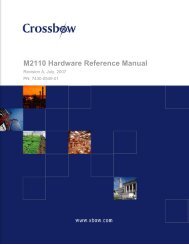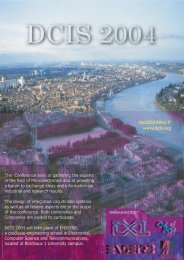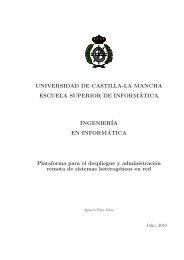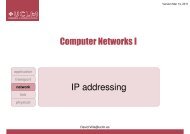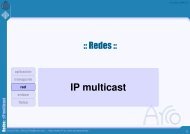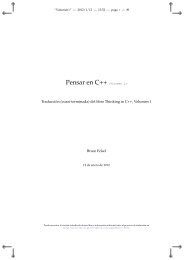tions come into play. These scenarios have been used to i<strong>de</strong>ntify the risks and vulnerabilities thatshould be consi<strong>de</strong>red when <strong>de</strong>veloping systems for Ambient Intelligence. Privacy, i<strong>de</strong>ntity, and securityare three major challenges that arise in pervasive contexts, such as those that characterize AmbientIntelligence, in which interconnected <strong>de</strong>vices handle user information, sometimes, susceptible of potentialrisks. The approach advocated by SWAMI is to consi<strong>de</strong>r security as a constituent part of the<strong>de</strong>velopment process, rather than being an add-on module that comes after having built the AmbientIntelligence framework. Additionally, privacy issues should not be ignored or overlooked, whichmeans that it needs to be specifically protected. One of the main conclusions achieved by the SWAMIproject was that the majority of the approaches presented to date violate the privacy boundaries. Inthis regard, new approaches to Ambient Intelligence should not only consi<strong>de</strong>r security issues as aconstituent part, but it is an unavoidable claim that they have to make special emphasis on protectinghuman privacy issues.The major contribution of this project is therefore the formalization and characterization of howsecurity and privacy issues can be addressed by any attempt to build an Ambient Intelligence framework.Additionally, the ultimate goal of this project is to come up with a set of research and policyoptions that dictate the step sequences that should drive the achievement of security and privacy-awaresystem.Finally, this thesis is not only framed in the European Union but also, in the Spanish researchcontext. In this sense, it is worth mentioning some of the initiatives that are being addressed to provi<strong>de</strong>solutions to Ambient Intelligence systems. In this regard, one of the currently ongoing projects,fun<strong>de</strong>d by the Spanish government, is being un<strong>de</strong>rtaken by a consortium of technological companiesand universities, un<strong>de</strong>r the Mao! project 10 . This project is mainly <strong>de</strong>voted to achieving Smart Spacesthrough the use of mobile phones. To this end, the mIO! project is addressing efforts at <strong>de</strong>signingand providing the appropriate technology capable of supporting ubiquitous services in Ambient Intelligence.This initiative pays a special attention to the key role that context performs in <strong>de</strong>terminingand characterizing the situation that surrounds end users. For that reason, significant efforts havebeen addressed to <strong>de</strong>velop a context management infrastructure, adopting to that end a middlewareapproach.Apart from the middleware framework, the role played by the proposed context mo<strong>de</strong>ling approachis also relevant. The work in [145] presents an ontology network especially <strong>de</strong>voted to mo<strong>de</strong>ling theuser’s contextual knowledge. Despite the fact that the semantic mo<strong>de</strong>l that they propose in [108] isinten<strong>de</strong>d to support the mo<strong>de</strong>ling task un<strong>de</strong>rtaken in Ambient Intelligence, it has to be noticed that itis addressed from a different perspective than the one presented here. It is a user and <strong>de</strong>vice centeredperspective that it is not concerned about the external factors that are affecting the context itself, andhow it could evolve as a result of external events. Besi<strong>de</strong>s, an additional reason that motivates theproposal of a new semantic mo<strong>de</strong>l rather than using the ontology proposed by the mIO! project isgroun<strong>de</strong>d in the need for conciseness and simplicity in the number of concepts and the relationshipsbetween them.Additionally, it has to be highlighted that scalability and privacy concerns have been carefullyconsi<strong>de</strong>red. In or<strong>de</strong>r to represent and mo<strong>de</strong>l the context information, this project has resorted to anontological approach. In or<strong>de</strong>r to exploit the benefits of providing context-sensitive services, it is alsoessential to count on appropriate means to localize and to recommend services on the basis of thecurrent context. It is still too soon to draw conclusions from the <strong>de</strong>velopment of this project since ithas just finished the first year of its four year duration.10 http://www.cenitmio.es/24
2.3 Middlewares for Ambient IntelligenceThe essential role played by communications in the Ambient Intelligence paradigms, makes it unavoidableto <strong>de</strong>dicate a specific section to revising the state of the art in middlewares for AmbientIntelligence. As for the previous section, the revision of the following projects has provi<strong>de</strong>d thisthesis with a clear i<strong>de</strong>a of the challenges that remain unsolved and those that have been successfullyaddressed by existing technologies.The first of the revised approaches is the HYDRA 11 project [36]. This project echoes the difficultiesof the middleware frameworks in supporting the communication and exchange of informationof the different off-the-shelf <strong>de</strong>vices. Different <strong>de</strong>vices implement different protocols, architectures,or programming languages. This fact complicates the interaction among different vendor <strong>de</strong>vicesand poses the need for a mechanism that abstract low-level <strong>de</strong>tails enabling <strong>de</strong>vice interaction. Thisproject is mainly motivated by the need to achieve a middleware framework that works as the abstractionlayer that enables a transparent communication in<strong>de</strong>pen<strong>de</strong>ntly of the <strong>de</strong>vice. This project hastherefore inten<strong>de</strong>d to <strong>de</strong>velop a middleware solution capable of enabling seamless access to different<strong>de</strong>vices, bearing in mind at the same time the need to comply with security concerns.The most appealing aspect of the HYDRA middleware is the breakthrough statement they promote,as it is the fact that if <strong>de</strong>vice capabilities could be semantically <strong>de</strong>scribed in such a way thatan intelligent agent could un<strong>de</strong>rstand and use them, the problem of <strong>de</strong>vice interoperability wouldhave been bridged [64]. Since the proposed middleware implements a Service-Oriented Architecture(SOA), achieving interoperability among heterogeneous <strong>de</strong>vices implies that services can be easilycombined, in the sense of composite services, by means of semantic <strong>de</strong>scriptions of the composition.The notion of semantic <strong>de</strong>vice proposed by HYDRA is particularly interesting. It is used to<strong>de</strong>scribe the services that a particular application would <strong>de</strong>sire a <strong>de</strong>vice to provi<strong>de</strong>. In this sense,HYDRA makes a distinction between a physical <strong>de</strong>vice and a semantic <strong>de</strong>vice. At some point, thisapproach can be seen as a specific type of service composition, in a sense that the composite serviceis mo<strong>de</strong>led in HYDRA as a semantic <strong>de</strong>vice. At the implementation level, programmers just need to<strong>de</strong>al with the semantic <strong>de</strong>vice, which will later on be statically mapped onto physical <strong>de</strong>vice services.In or<strong>de</strong>r to accomplish such static mapping, knowledge about such services and <strong>de</strong>vices is required.By implementing such an approach, programmers are abstracted from <strong>de</strong>aling with all the activitiesthat would be involved in the mapping tasks, such as service discovery, access to physical <strong>de</strong>vices,and mapping onto the programmed instance. On the contrary, using the semantic <strong>de</strong>vice abstractionrelieves the programmer from having to manually address the involved previous steps.HYDRA has also taken care of easing the process of co<strong>de</strong> generation for the semantic <strong>de</strong>viceabstractions. This has been achieved by adopting a Mo<strong>de</strong>l-Driven Approach that, based on a <strong>de</strong>scriptivemo<strong>de</strong>l of the services provi<strong>de</strong>d by the semantic <strong>de</strong>vice, it automatically generates the co<strong>de</strong>concerning the service call. Furthermore, it is also responsible for <strong>de</strong>termining the physical <strong>de</strong>vicethat is implementing the service, and prepare the data to be provi<strong>de</strong>d to the services.The only <strong>de</strong>tail that appears to be missing is the capability to automatically generate semantic services,rather than expecting programmers to specify them. In this sense, automating some aspects ofthe implemented mo<strong>de</strong>l-driven approach, it could be possible to automate the generation of semantic<strong>de</strong>vices. However, HYDRA does not consi<strong>de</strong>r this capability and the semantic <strong>de</strong>vice generation canonly be carried out by programmers.The MORE 12 project [45] is <strong>de</strong>voted to addressing the problem that un<strong>de</strong>rlies the way humans11 http://www.hydramiddleware.eu/news.php12 ist-more.org25
- Page 1: DEPARTAMENTO DE TECNOLOGÍAS Y SIST
- Page 4 and 5: María José Santofimia RomeroTelé
- Page 7: ResumenLa Inteligencia Ambiental, p
- Page 11 and 12: ContentsContentsList of TablesList
- Page 13: CONTENTSVII7.4.4 The Plan Executor
- Page 17: List of Figures4.1 Kripke model for
- Page 21: Part IPreliminaries3
- Page 24 and 25: This gap poses an urgent need to de
- Page 26 and 27: and events, and the mechanisms to r
- Page 28 and 29: Maria’s ankle as an impediment to
- Page 30 and 31: 1.3 Aims and objectivesGiven that t
- Page 32 and 33: The fourth item concerns the way th
- Page 34 and 35: of such goals and desires and how t
- Page 36 and 37: tion, is addressed by coping with a
- Page 38 and 39: networking from being widely spread
- Page 40 and 41: The MERL’s Ambient Intelligence f
- Page 44 and 45: interact with electronic devices, e
- Page 46 and 47: tionally, the middleware architectu
- Page 48 and 49: The idea behind the work proposed h
- Page 50 and 51: esources under a middleware based o
- Page 53: Part IIUnderstanding35
- Page 56 and 57: obvious. In this sense, sociologist
- Page 58 and 59: true throughout a time interval, or
- Page 60 and 61: application domain is (true, false)
- Page 62 and 63: (SubAsbstrac Nathan Nathan2007)(Sub
- Page 64 and 65: Moreover, events not only cannot be
- Page 66 and 67: epresented by means of the notion o
- Page 68 and 69: Context-awareness is one of the mai
- Page 70 and 71: In any case, the adopted behavioral
- Page 72 and 73: when the water level starts increas
- Page 74 and 75: Traditionally, these responses have
- Page 76 and 77: true.Additionally, the meaning of t
- Page 78 and 79: (6) Statement → Service-ID perfor
- Page 80 and 81: the set of possible contexts, and M
- Page 82 and 83: in which S is a nonempty set of sta
- Page 84 and 85: are considered possible given the p
- Page 86 and 87: cope with the demands involved in d
- Page 89 and 90: Chapter 5Understanding Context Situ
- Page 91 and 92: Figure 5.1: Overall view of the pro
- Page 93 and 94:
adjusting existing knowledge to sim
- Page 95 and 96:
of some events involves the stateme
- Page 97 and 98:
( new-statement { picker } {is loca
- Page 99 and 100:
The way of determining which after
- Page 101 and 102:
CL-USER > ( the-x-of-y-is-z { enter
- Page 103 and 104:
CL-USER > ( the-only-x-of-y-is-z {
- Page 105 and 106:
CL-USER > ( get-element-fluent ( lo
- Page 107 and 108:
The specificity of the propositiona
- Page 109 and 110:
Following the same dynamic, the dif
- Page 111:
part is intended to propose a solut
- Page 115 and 116:
Chapter 6Behavioral Response Genera
- Page 117 and 118:
and action selection by means of a
- Page 119 and 120:
wants the room to be at a higher te
- Page 121 and 122:
state of the world with those plann
- Page 123 and 124:
conflict. The later strategy requir
- Page 125 and 126:
Function f returns the actions, fro
- Page 127:
next step selected in the plan. The
- Page 130 and 131:
of it. It is also possible to try t
- Page 132 and 133:
Agent System (MAS), individual agen
- Page 134 and 135:
the requirements stated for the BRG
- Page 136 and 137:
The action planning algorithmMaking
- Page 138 and 139:
The advantages underlying service c
- Page 140 and 141:
effects. On the contrary, an approp
- Page 143:
Part IVValidation and discussions12
- Page 146 and 147:
taking place. The interpretation of
- Page 148 and 149:
The key elements of the evaluation
- Page 150 and 151:
also been proved to serve as a mean
- Page 152 and 153:
Table 8.2: Simulation Configuration
- Page 154 and 155:
the knowledge-base, it saves time i
- Page 156 and 157:
effects and the sensed ones leads t
- Page 158 and 159:
Table 8.3: Personal information of
- Page 160 and 161:
Scenario Interpretations Number of
- Page 162 and 163:
understand the terms used to descri
- Page 164 and 165:
Finally, the causal explanation app
- Page 166 and 167:
2. A2: To provide a service composi
- Page 168 and 169:
System has to be motivated by goals
- Page 170 and 171:
een addressed by this thesis. Howev
- Page 173 and 174:
Bibliography[1] Gregory D. Abowd, A
- Page 175 and 176:
[25] Diane J. Cook, Juan C. Augusto
- Page 177 and 178:
[54] Tao Gu, Hung Keng Pung, and Da
- Page 179 and 180:
[83] Clemens Lombriser, Nagendra B.
- Page 181 and 182:
[110] Davy Preuveneers, Jan Van den
- Page 183 and 184:
[134] John F. Sowa. Conceptual Stru
- Page 185:
Part VIAppendix167
- Page 188 and 189:
Ambient Intelligence environment, i
- Page 190 and 191:
invocation. However, in reality the
- Page 192 and 193:
consists in querying the Topic Mana
- Page 194 and 195:
Figure A.4: Multi-Agent System over
- Page 196 and 197:
The result of the planning algorith
- Page 198 and 199:
concepts and relationships are impl
- Page 200 and 201:
As listed below, the recognition ac
- Page 202 and 203:
184Figure A.8: Sequence diagram for
- Page 204 and 205:
}query = " ( b−wire ( car ( list
- Page 207:
Este documento fue editado con GNU


